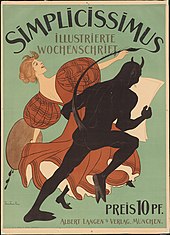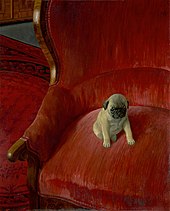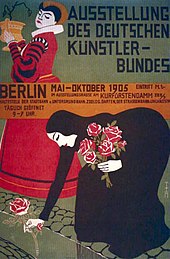Thomas Theodor Heine

Thomas Theodor Heine (also: Th. Th. Heine ; born February 28, 1867 as David Theodor Heine in Leipzig ; † January 26, 1948 in Stockholm ) was a German-Swedish painter , draftsman , commercial artist and writer .
Life
Heine came from an upper-class Jewish family. He was the second son of the rubber goods manufacturer Isaak Heine and his wife Esther (née Hesse).
He studied at the St. Thomas School in Leipzig . After he had published some caricatures anonymously in the Leipziger Pikanten Blätter (publisher: Leopold von Sacher-Masoch ) in March 1884 and his name had become known, he was expelled from school shortly before graduating from high school. He then began his artistic training at the Düsseldorf Art Academy from 1885 to 1886 with Hugo Crola and, after a break, in 1887 with Johann Peter Theodor Janssen , but after differences with fellow students in the Tartarus Academy student association, he soon moved to Munich , where he worked as a landscape painter and finally hired as a draftsman and caricaturist for the Fliegende Blätter from 1892 .
In 1895 he met the publisher Albert Langen , who in the following year involved him in the conception of a new political- satirical weekly newspaper: the Simplicissimus , which enjoyed rapidly growing popularity and which shaped Heine with its distinctive drawing style until 1933. He also designed the magazine's logo, the red bulldog .
In addition to the Simplicissimus , Heine continued to work for the Fliegende Blätter . As a commercial artist , he created a number of posters and advertisements , for example for the sparkling wine cellars Henkell (Wiesbaden), Schloss Wachenheim (Frankfurt am Main) or for the Kunsthaus Brakl in Munich. In 1898 Heine was sentenced to six months' imprisonment for insulting majesty , but was subsequently pardoned to imprisonment at Königstein Fortress in the Kingdom of Saxony , which he served with Frank Wedekind .
Since 1917, Heine lived with his wife and daughter mainly in a house in Dießen am Ammersee that had been used for summer holidays . Later he also built his own studio building here.
In 1933, Heine, who had fought the Nazis early on with vicious articles and cartoons, was persecuted by the Nazis. At the beginning of April 1933, for example, with the threat of having him sent to a concentration camp, the Bavarian Nazi Interior Minister Wagner forced him to give up his seat in the editorial office of Simplicissimus and his shares in the newspaper. Even so, he was to be arrested shortly afterwards. However, Heine was able to flee from Munich to Berlin first, where the Hans Purrmann and Mathilde Vollmoeller-Purrmann family hid him in their apartment for a few weeks. Mathilde Vollmoeller-Purrmann organized the passport of a deceased relative for Heine, which Hans Purrmann then prepared so that Heine could travel to Prague with it. Then Heine had to flee the country at the age of 66 - he ended up in the Czechoslovak Republic . Shortly after his escape, the local NSDAP leadership tried to expropriate Heine's house. This finally succeeded in 1938. Heine's wife and daughter had to sell the property, which was located on the site of today's Augustinum residential monastery, to the community for below value.
Heine was completely destitute in exile. In 1936 he settled in Brno , where friends had offered him a free apartment. After the occupation of the Sudetenland in 1938, with the help of Ragnvald Blix , he succeeded in obtaining a residence permit for Norway , where he was able to work as a draftsman for the Oslo Dagbladet , among other things .
In early 1939, Heine met Max Tau , the former literary director and editor of the Bruno-Cassirer- Verlag, who had also fled Germany because of his Jewish origins and had arrived in Oslo shortly afterwards. The two met regularly from then on. After the occupation of Norway in April 1940, Heine was briefly arrested and released under the condition that he would not publish anything more. Tau encouraged Heine to work on an autobiographically motivated satirical novel. In 1942, Heine anticipated the threat of arrest by fleeing to Sweden. There he was able to continue working on the novel. It was first published in Swedish in 1944 and was published in German in early 1945 under the title Ich warte auf Wunder as one of the first books by Taus Neuem Verlag . A Danish and an English edition followed in 1946 and 1947 respectively, the German first edition not until 1962.
On his 80th birthday, Heine, who had meanwhile been granted Swedish citizenship, was honored with a large retrospective in the national museum there. The first major exhibition of his artistic work in Germany did not take place until autumn 2000: in the Städtische Galerie im Lenbachhaus in Munich .
Thomas Theodor Heine was a board member in the German Association of Artists . The poster for the second annual exhibition of the DKB in Berlin in 1905 came from him.
Other works
- Literature by and about Thomas Theodor Heine in the catalog of the German National Library
- The fairy tale . Querido Verlag NV Amsterdam, 1935 (1978 photomechanical reprint by Aufbau-Verlag Berlin and Weimar; new edition under the title Strange happens , Braunschweig: Klemm, 1946).
- The truth is often unlikely. Thomas Theodor Heine's letters to Franz Schoenberner from exile . Edited by Thomas Raff. Göttingen: Wallstein, 2004. ISBN 3-89244-465-X .
literature
- Theo Neteler: "Adorned by Th. Th. Heine". Thomas Theodor Heine worked as a book artist for Insel-Verlag . In: From the second-hand bookshop . NF 13, no. 2 , 2015, p. 66-75 .
- Jörg Meißner (Ed.): Strategies of the art of advertising 1850–1933. Catalog for the exhibition in the German Historical Museum from April 22 to August 29, 2004 . Bönen: Kettler, 2004.
- Volker Oppmann: Max Tau and the Neue Verlag. A chapter in the history of German exile literature . Berlin: Dreiviertelhaus Publishing House, 2017.
- Thomas Theodor Heine - on the occasion of the exhibitions in the Städtische Galerie im Lenbachhaus and Kunsthaus, Munich, from September 9th to November 26th, 2000 and in the Bröhan-Museum, Country House Museum for Art Nouveau, Art Deco and Functionalism Berlin, from December 16, 2000 to November 18, 2000 March 2001. Edited by Helmut Friedel. Seemann, Leipzig 2000, ISBN 978-3-363-00744-2 .
- Catalog Part I: Thomas Raff: Thomas Theodor Heine - The Bite of Simplicissimus. The artistic work .
- Catalog Part II: Monika Peschken-Eilsberger: Thomas Theodor Heine: The Lord of the Red Bulldog. Biography .
- Brigitte Struzyk: Epilogue , in: Th. Th. Heine: I'm waiting for miracles . Novel. Berlin: Rütten and Loening, 1984, pp. 476–509.
- Friedrich Ahlers-Hestermann: Heine, Thomas Theodor. In: New German Biography (NDB). Volume 8, Duncker & Humblot, Berlin 1969, ISBN 3-428-00189-3 , p. 295 f. ( Digitized version ).
Web links
- Works by Thomas Theodor Heine in the Gutenberg-DE project
- Thomas Theodor Heine in the Bavarian literature portal (project of the Bavarian State Library )
- Janca Imwolde: Thomas Theodor Heine. Tabular curriculum vitae in the LeMO ( DHM and HdG )
- simplicissimus.info Simplicissimus (49 years, 1896–1944) - free online edition
Individual evidence
- ↑ Inventory signature BR 0004 No. 1561 of the Kunstakademie Düsseldorf, sheet 515V, school year 1885, remark: left the academy in November 1886 due to differences with his classmates and sheet 558V school year 1886, remark: was expelled from the academy in November 1886 for a year of his request , in preparatory class A from Hugo Crola with behavior not faultless and not good.
- ↑ Inventory signature BR 0004 No. 1561 of the Düsseldorf Art Academy, sheet 608V, school year 1887, ancient and natural class by Peter Janssen, remark: missing for a long time due to illness
- ↑ LeMO biography: Thomas Theodor Heine 1867-1948
- ^ Franz Schoenberner : Confessions of a European Intellectual. Volume I. Kreisselmeier, Icking et al. 1946.
- ^ Adolf Leisen: For the painter's 125th birthday - Purrmann and his friends. In: Palatinate Art Portal. April 10, 2005, archived from the original on October 29, 2007 ; accessed on December 30, 2014 .
- ↑ Thomas Raff: Th. Th. Heine was born 150 years ago. Ammerseekurier March 31, 2017.
- ↑ kuenstlerbund.de: Ordinary members of the German Association of Artists since it was founded in 1903 / Heine, Thomas Theodor (accessed on August 19, 2015)
| personal data | |
|---|---|
| SURNAME | Heine, Thomas Theodor |
| ALTERNATIVE NAMES | Heine, Th. Th .; Heine, David Theodor (maiden name) |
| BRIEF DESCRIPTION | German painter, draftsman, commercial artist and writer |
| DATE OF BIRTH | February 28, 1867 |
| PLACE OF BIRTH | Leipzig |
| DATE OF DEATH | January 26, 1948 |
| Place of death | Stockholm |



